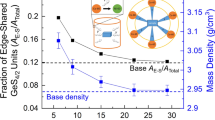Abstract
Silicone polymers were pyrolyzed to form silicon oxycarbides that contained only silicon, oxygen, and carbon. The starting polymers were mainly methyl trichlorosilane with a small amount of dimethyl dichlorosilane. NMR showed that the polymers had a silicon-oxygen backbone with branching and ring units. When the polymer was heated in hydrogen, toluene and isopropyl alcohol, used in production of the polymer, were given off in the temperature range 150 °C to 500 °C. Substantial decomposition of the polymer itself began only above about 700°by evolution of methane. The network of silicon-oxygen bonds and silicon-carbon bonds did not react and was preserved; the silicon-carbon bonds were linked into the silicon-oxygen network. The silicon oxycarbide was stable above 1000 °C, showing no dimensional changes above this temperature. The interior of the silicon oxycarbide was at very low effective oxygen pressure because oxygen diffused slowly in it. There was also a protective layer of silicon dioxide on the surface of the silicon oxycarbide.
Similar content being viewed by others
References
S. Sakka, in Treatise on Mater. Sci. and Technol., edited by M. Tomozawa and R. H. Doremus (Academic Press, San Diego, CA, 1982), Vol. 22, pp. 129–167.
K. J. Wynne and R. W. Rice, Ann. Rev. Mater. Sci. 14, 297–334 (1984).
C. J. Brinker and G. W. Scherer, Sol-Gel Science (Academic Press, San Diego, CA, 1990).
R. B. Ellis, “Method of Making Electrically Conductive Glass and Articles Made Therefrom”, U.S. Patent No. 2556616 (1951).
C. F. Smith, “The Vibrational Spectra of High Purity and Chemically Substituted Vitreous Silicas”, Ph.D. Thesis, Alfred Univ., Alfred, NY, 1973.
T. H. Elmer and H. E. Meissner, J. Am. Ceram. Soc. 59, 206–209 (1976).
S. Yajima, J. Hayashi, and M. Omori, Chem. Lett. 9, 931 (1975).
R. F. Cooper and K. Chyung, J. Mater. Sci. 22, 3148–3160 (1987).
T. Mah, N. L. Hecht, D. E. McCullum, J. R. Hoenigman, H. M. Kim, A P. Katz, and H. A. Lipsitt, J. Mater. Sci. 19, 1191–1201 (1984).
F. Babonneau, K. Thorne, and J. D. Mackenzie, Chem. of Mater. 1, 554–558 (1989).
G. M. Renlund, “Silicon Oxycarbide Glasses”, Ph.D. Thesis, Rensselaer Polytechnic Institute, Troy, NY, 1989.
K. A. Saunders, Organic Polymer Chemistry (Chapman and Hall, New York, 1973), pp. 347–369.
NMR Basic Principles and Progress, edited by P. Diel, E. Fluck, and R. Kosfeld (Springer-Verlag, Frankfurt, Germany, 1981), p. 184ff.
H. L. Schick, Chem. Rev. 60, 331–362 (1960).
R. H. Doremus, in The Physics and Chemistry of SiO2 Interface, edited by C. R. Helms and B. E. Deal (Plenum Press, New York, 1988, pp. 17–23.
R. M. Barrer and D. E. W. Vaughn, Trans. Faraday Society 63 (9), 22752290 (1967).
Author information
Authors and Affiliations
Rights and permissions
About this article
Cite this article
Renlund, G.M., Prochazka, S. & Doremus, R.H. Silicon oxycarbide glasses: Part I. Preparation and chemistry. Journal of Materials Research 6, 2716–2722 (1991). https://doi.org/10.1557/JMR.1991.2716
Received:
Accepted:
Published:
Issue Date:
DOI: https://doi.org/10.1557/JMR.1991.2716




